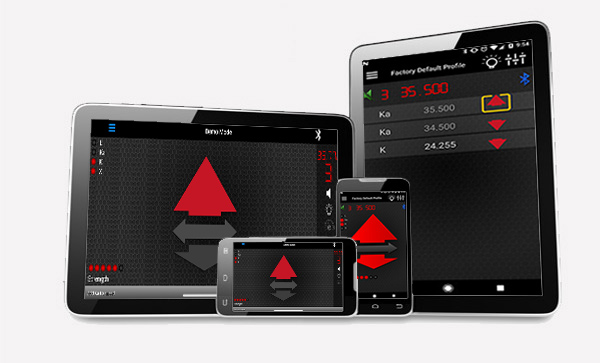Radar detector plus radar locator, all in one.
We invented Radar Location back in the 90’s.

Now we’re taking it to the next generation…

Radar Locator
Red arrows instantly point to every threat

Bogey Counter
Tells how many threats, reads instantly

Threat ID
LED identifies laser or radar band

Full Coverage
Front and rear antennas scan all around your car
Easy smartphone connection.
Connect to any compatible device you already have.
Shipped straight to you.
Frequently asked questions
Click here to view all improvements.
Here’s the fallacy with GPS detectors—they can’t block a signal at its source because they don’t know where that is. They know only where your car is, so they block a zone all around your car. This may be okay in a weak detector, but a long-range detector may find that signal a mile away. Now GPS works against you because the block covers a huge zone. Worse yet, the block doesn’t pinpoint a single frequency, it blocks a wider band of frequencies that includes the offending signal. Now if traffic radar sets up within that blocked territory around your car, on a frequency within the blocked band, you’ll get no warning.
We think blocking signals we can’t pinpoint is too risky. Instead, V1 Gen2 characterizes every signal we find using our patented
 high-speed signal processor, then weeds out the ones that don’t fit the pattern of speed radar. V1 Gen2 combines long range with lowered risk.
high-speed signal processor, then weeds out the ones that don’t fit the pattern of speed radar. V1 Gen2 combines long range with lowered risk.
last revised 4/20/2020
Also known as Blind Spot Warning (BSW), lane-change warning, side-assist and similar sounding names, these are usually radar-based systems using K band. They warn the driver of a vehicle in the way of a lane change. V1 Gen2 resists interference from almost all of them. However, there is a specific radar sensor used in some 2013-2016 GM vehicles that we’re still working on. The same sensor is also used in some 2007-2012 Mercedes Benz vehicles and 2011-2013 Chrysler and Jeep vehicles. To minimize the problem, owners of those vehicles can enter V1 Gen2’s programming mode and switch on feature G. For more info, please click here.
Vehicles whose Blind Spot Warning systems cause K-band false alarms on V1 Gen2 at this time (4-2-2020).
2013 – 2017 Buick Enclave and Buick Verano
2013 – 2016 Cadillac SRX
2013 – 2017 Chevy Traverse
2014 – 2016 Chevy Impala, Chevrolet SS, Chevy Equinox, Chevy Cruze, and Chevy Volt
2011 – 2012 Chrysler Town & Country, Chrysler 300
2011 – 2012 Chrysler 300
2013 – 2017 GMC Acadia
2014 – 2016 GMC Terrain
2011 – 2013 Jeep Grand Cherokee
2007 – 2012 Mercedes-Benz (C, E, GL, GLK, ML, R, and SLS class)
2014 Mercedes-Benz SL63last revised 4/20/2020
Also known as Rear Cross Traffic Warning (RCTW) or similar sounding names, these systems are usually tied in with Blind Spot Warning systems on K band. When reverse has been engaged, the system will warn of a vehicle or object approaching from behind on either side of the vehicle or directly from behind, yet out of rear camera range. Some systems will even apply the brakes to avoid impact. V1 Gen2 resists interference from RCTW radar.
last revised 4/20/2020
Also known as Forward Collision Warning (FCW), crash-mitigation warning, adaptive cruise control, automatic-emergency braking or similar sounding names. These systems warn a driver of an impending collision with a car or object directly in its forward path. Some systems apply the brakes, sometimes firmly enough the bring the vehicle to a full stop. While most of these radars operate on 77 GHz, which does not trigger an alert in V1 Gen2, some systems in GM, Mercedes-Benz and commercial vehicles use K-band radar. V1 Gen2 resists interference from those systems in Mercedes-Benz and commercial vehicles. However, the following list of GM vehicles will trigger a forward K-band alert in V1 Gen2: 2013-2016 Cadillac SRX, ATS, CTS, XTS and Escalade. Vehicle manufacturers are generally moving toward the higher-frequency 77 GHz system.
last revised 4/20/2020
Mazda’s Smart City Brake, Volvo’s City Safety, and Toyota’s Safety Sense C (TSS-C) are forward crash-mitigation systems that use laser to “see” the road ahead. Since they use the same laser wave length as speed-enforcement laser, they trigger a similar laser warning in V1 Gen2. Mazda and Volvo models from 2012-2018 will continue to be troublesome until we release a firmware update sometime later in 2020. The good news is that all Mazda and Volvo vehicles redesigned since 2015–some didn’t get redesigned until 2018–no longer use the laser-based system. Toyota, on the other hand, continues to equip the Corolla hatchback, Prius, and Yaris with the problematic laser.
The ADAS (advanced driver-assistance system) in some 2019 and newer Cadillac and Audi models uses a forward laser scanner for crash-mitigation, which can present a problem for V1 Gen2.
Some 2000–2004 Lexus vehicles, 2004–2013 Toyotas, and 2003–2013 Infiniti models are equipped with an optional laser-based crash-mitigation system that can interfere with V1 Gen2. Since the laser-based system was an option available only on the highest-trim level, this concern will continue fading away as age takes these cars off the road.
last revised 4/20/2020




